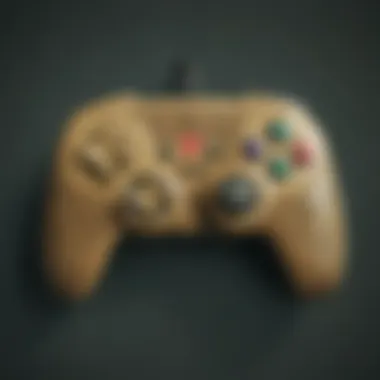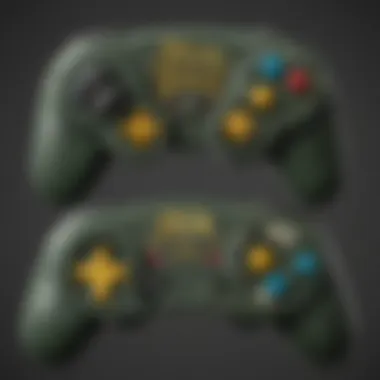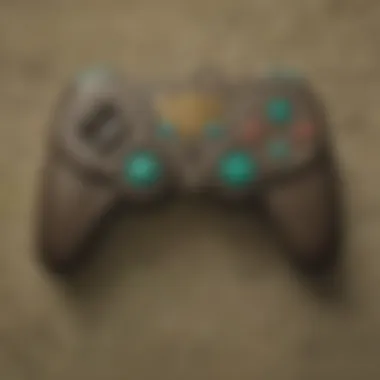The Legacy of the Legend of Zelda Controller


Intro
The Legacy of the Legend of Zelda controller represents more than just a mere interface for gameplay. It symbolizes an evolution in how players interact with a beloved franchise. This analysis aims to provide a comprehensive look at the development and impact of these controllers. By examining their design innovations and technical specifications, we will uncover their significance to player experiences across different iterations of the Zelda series.
Throughout our journey, we’ll explore how community feedback and industry advancements shape the controllers today. With this exploration, we embrace a deeper understanding of how these devices have affected gameplay mechanics and player enjoyment.
Game Reviews
Gameplay Features and Mechanics
The controllers have always been engineered to enhance gameplay features within the Zelda series. From the iconic NES controller to the more advanced Nintendo Switch Pro Controller, each has contributed uniquely to the mechanics of gameplay. The D-pad functionality on the NES controller allowed for precise navigation, crucial for solving intricate puzzles, while the dual analog sticks on the Nintendo Switch introduced a level of fluidity in movement and camera control that dramatically changed exploration dynamics.
Storyline and Quests
Zelda games are renowned for their intricate storytelling. The controllers have subtly influenced the way narratives unfold. Features like vibration alerts for critical story moments provide a tactile connection to the story. The introduction of motion controls allowed players to feel more involved in quest-solving, making the experience immersive. This interaction enhances players' emotional investment in the game’s narrative.
Visuals and Sound Design
Visual fidelity in Zelda games has progressed alongside controller development. For instance, the Wii U GamePad enabled players to experience dual-screen gameplay, a shift that altered how visuals were presented. In terms of sound, the ability to adjust volume directly via the controller added accessibility and allowed players to engage more deeply with the game’s auditory world, enhancing the overall atmosphere.
Comparison with Previous Titles
When comparing various controllers, distinct differences in handling and ergonomics become apparent. The GameCube controller is celebrated for its unique design, which some argue provided the best gameplay experience for titles like "The Wind Waker." While newer models focus on broader functionality, it’s the nostalgic feel of older controllers that many players still cherish. Each iteration serves a purpose and reflects the technological advancements and design philosophies of its time.
"The control experience can make or break a player’s connection to a game—Zelda’s controllers have always aimed to fortify that bond."
Player Perspectives
Players have shared varied experiences. Following community feedback, Nintendo enhanced features based on user preferences. For instance, the ergonomic design of the Pro Controller responds to long gameplay sessions, minimizing discomfort.
Epilogue
As we conclude this analysis, it’s clear that the legacy of the Legend of Zelda controller is foundational. The marriage of innovative design and gameplay mechanics continues to shape the way players interact with this beloved franchise. The future hints at further enhancements, perhaps integrating virtual reality or even more personalized controls.
Thus, as we reflect on the past and look ahead to future innovations, the controllers remain crucial elements in bridging the gap between player and game.
Prelims to the Legend of Zelda Franchise
The Legend of Zelda franchise is a cornerstone of the gaming world. It has shaped narratives, mechanics, and player expectations since its inception. To understand the legacy of the associated controllers, one must first appreciate the franchise itself. This background knowledge sets the stage, informing how the controllers became integral to enhancing gameplay and providing a lasting impact across generations.
Overview of the Franchise
The Legend of Zelda originated in 1986, developed by Nintendo. This action-adventure game combined elements of exploration, puzzle-solving, and combat. Players took control of Link, navigating the land of Hyrule to save Princess Zelda and defeat the antagonist Ganon. Over the years, it evolved with various installments, each introducing innovative game mechanics while retaining the core essence that fans have come to love.
The series includes titles like "Ocarina of Time," "Breath of the Wild," and many others. These games not only showcase compelling storylines and vibrant worlds but also rely on unique controller inputs to bring the experience to life. The relationship between a game and its controller becomes crucial as gameplay mechanics depend heavily on how players interact with the game.
Historical Significance in Gaming
The Legend of Zelda holds a notable place in gaming history. It was one of the first games to create a non-linear open-world experience. Players could explore vast surroundings at their discretion. This innovation influenced later games significantly. Additionally, the franchise has received numerous awards and critical acclaim throughout its existence.


From the original NES controller to the modern consoles, each controller design has mirrored advancements in technology and player expectations. As the franchise progressed, the controllers were not just tools but extensions of the player themselves, influencing both gaming culture and design philosophy. The importance of the franchise cannot be overstated; it represents a bridge between generations of gamers, molded by the respective controllers of its time.
The evolution of gaming controllers, particularly in the Zelda franchise, exemplifies how design can enhance the narrative and gameplay experience.
Understanding these themes prepares the reader for a deeper analysis of how the controllers have evolved alongside the franchise, further emphasizing their impact on player experience and legacy.
The Evolution of Gaming Controllers
The development of gaming controllers has shaped not only the mechanics of gameplay but also the way players interact with their favorite titles, including those in the Legend of Zelda series. Understanding this evolution is crucial for appreciating the innovations incorporated into Zelda's controllers. Each iteration of the controller brings unique features and designs that enhance player engagement and experiences.
Early Gaming Controllers
In the beginning, gaming controllers were simple and rudimentary. The early designs primarily included joysticks and a few buttons. For example, the Atari 2600 controller featured a joystick for movement along with a single red button for action commands. This basic setup laid the groundwork for future controller designs.
The simplicity of these controllers had its merits. They were straightforward, allowing new players to easily grasp the fundamentals of gaming. However, limitations soon became apparent. Games started requiring more complex commands, leading to frustration for players who had to adapt to these constraints.
As the gaming landscape evolved, controllers also began to diversify in their designs and functions. The introduction of buttons, like those seen in the Nintendo Entertainment System (NES) controller, revolutionized gameplay. This transition allowed for stronger interaction with the game. Players no longer needed just a joystick; they could perform multiple actions with their thumbs while navigating worlds and characters.
Transition to Home Consoles
The shift from arcade gaming to home consoles marked a significant turning point in controller design. As more households acquired gaming systems, developers worked on more sophisticated controllers to enhance gameplay. The Super Nintendo Entertainment System (SNES) introduced features such as shoulder buttons and improved ergonomics. This offered players a more comfortable grip and allowed for more complex actions in gameplay.
The layout of the Sega Genesis controller also made an impact. It included a six-button layout, which set a new standard for action and complexity in games. The new design elements made controlling characters and executing moves more intuitive. This transition not only increased accessibility for new players, but also deepened the strategic possibilities for seasoned gamers.
The evolution of the gaming controller reflects a desire to balance simplicity with complexity. As controls became more advanced, the fundamental goal remained the same: to provide players with a seamless and engaging experience. In this ongoing evolution, the Legend of Zelda series has consistently benefited from controller innovations that not only enhance gameplay but also reinforce the series' iconic status in the gaming world.
"The evolution of gaming controllers mirrors the advancements in gameplay complexity and player expectations across generations."
Understanding the evolution of gaming controllers sets the foundation for appreciating the designs specific to the Legend of Zelda series. It is within this legacy that the relationship between controller design and gameplay is fully realized.
Controllers Specific to the Legend of Zelda
The controllers specific to the Legend of Zelda series offer a lens through which we can understand not just the evolution of gaming hardware, but also the very nature of player interaction with one of the most iconic franchises in video game history. Each controller has its unique design that reflects the technological advancements of its time and the specific gameplay needs of Zelda titles. This aspect also highlights the symbiotic relationship between game design and controller functionality. Key elements, such as button layout and ergonomic considerations, are essentials that play a vital role in a player's experience.
The NES Controller and Zelda
The NES controller, released in 1983, set the foundation for console gaming. Its simple design featured a directional pad and just two action buttons, which allowed players to navigate Hyrule in the first Legend of Zelda game. This simplicity is deceptive; it fosters an engaging gameplay experience. Players had to develop skills in timing and strategy, and the controller’s layout was pivotal in delivering this. The D-pad provided intuitive movement, while the buttons were responsive enough to handle quick commands, crucial in combat and exploration.
The SNES Controller and Link to the Past
Fast forward to 1991, the introduction of the SNES controller brought about significant improvements. This controller included two additional buttons, enhancing complexity and depth in gameplay. Games like The Legend of Zelda: A Link to the Past utilized these buttons effectively, allowing for more intricate interactions like item management. The added shoulder buttons improved comfort during long play sessions. Ergonomics took a leap forward here, promoting longer engagement with the game, thus deepening the players’ connection to the narrative and world of Zelda.
The N64 Controller and Ocarina of Time
The N64 controller marked a major shift with the introduction of the analog stick. Released with The Legend of Zelda: Ocarina of Time in 1998, it allowed for nuanced movement in 3D space, a crucial aspect of navigating the expansive land of Hyrule. The layout was unconventional, causing some initial confusion, but it enabled players to perform tasks with greater precision, such as targeting foes or executing reflexive dodges. Many players have nostalgic reflections on using this controller, underscoring its iconic status in gaming history.
The GameCube Controller and The Wind Waker
The GameCube controller continued this trajectory of innovation when it was released in 2001. For The Legend of Zelda: The Wind Waker, the controller's distinct layout facilitated smooth sailing and exploration. The use of both analog and digital inputs allowed for intricate control over Link's movements, especially in an open-world setting. One notable feature is the design of the buttons: they were shaped and positioned such that a player’s fingers fell into place naturally, enhancing comfort and usability. The GameCube controller elevated player experience by adapting to the nuances of gameplay while remaining intuitive.
Technical Specifications and Features


Understanding the technical specifications and features of controllers within the Legend of Zelda series is critical in deciphering how they have shaped not just gameplay mechanics but also player engagement. Controllers serve as the intermediary between the player and the game universe. Each controller variation has brought forward unique capabilities that enhance or modify how players interact with the game.
Button Layout and Functions
The button layout of a controller is fundamental. It dictates accessibility and ease of use. In the case of the Legend of Zelda controllers, the design often aligns with the gameplay demands present in each title. For instance, in Ocarina of Time, the N64 controller's unique three-pronged shape allowed players to adeptly navigate the expansive world of Hyrule while simultaneously managing various items through easily reachable buttons.
The arrangement is not merely about having buttons but also understanding their functions and how they correlate with gameplay. Players rely on specific button configurations that allow for quick responses, which can be vital in high-pressure scenarios. Key features traditionally include:
- Action buttons for jumps and attacks.
- Context-sensitive buttons that change functions based on the player’s surroundings.
- Inventory management buttons that enable rapid item switching.
This careful consideration of button placement and functionality reflects an awareness of player needs. As technology advanced, features like the inclusion of additional buttons on the GameCube controller further enriched gameplay, allowing for more complex interactions without overwhelming the player.
Analog Sticks and D-Pads
Analog sticks and D-Pads are crucial for offering diverse control schemes. The shift from a traditional D-Pad to the inclusion of analog sticks marked a significant evolution in controller designs. In The Wind Waker, the GameCube controller's analog stick permitted nuanced movement that was essential for sailing and exploration, crafting a more immersive experience.
The D-Pad, while more simplistic, is significant too. Its role in navigating menus and settings cannot be understated. Players frequently utilize the D-Pad for quick item selection or navigation during gameplay. Its straightforward functionality may seem simplistic, yet it remains essential in keeping the interface user-friendly and intuitive.
The effectiveness of these controls can lead to:
- Enhanced precision in character movements.
- Allows players to execute complex maneuvers more easily.
- Provides the necessary feedback for accurate input during high-stakes encounters.
In summary, the technical specifications and features of controllers in the Legend of Zelda series underscore their impact on gameplay. They highlight the creators’ efforts to provide responsive, intuitive controls that mirror the evolving demands of both the narrative and game mechanics.
Impact of Controller Design on Gameplay
The design of a gaming controller plays a significant role in shaping the overall gameplay experience. In the context of the Legend of Zelda series, controllers have continually evolved to match the rich narrative and immersive world. Each controller introduced specific features that enhanced player experience, influencing how players interacted with the games. A deep dive into this subject reveals several key elements that highlight the importance of controller design.
Ergonomics and Comfort
Comfort is a critical aspect of controller design. For long gaming sessions, a controller that feels good in hand can make a world of difference. The Legend of Zelda controllers prioritize ergonomics, allowing players to navigate vast worlds without suffering from hand fatigue. Controllers such as the GameCube and the Wii U have curved shapes that fit naturally in users’ hands. This consideration for ergonomics allows players to engage more deeply with the game, as they can focus on the story and exploration rather than discomfort. The right grip design can even minimize strain, making lengthy puzzle-solving expeditions more enjoyable.
Precision in Gameplay
Precision defines the success of any gaming experience. In the Legend of Zelda franchise, precision becomes vital because many gameplay mechanics rely on accurate timing and movement. The introduction of analog sticks, especially in the N64 and GameCube controllers, allowed for more nuanced control over character movements. Players could now steer Link with greater accuracy, making targeting enemies or solving intricate puzzles easier. The tight response time of the buttons also improved the overall fluidity in gameplay. Well-designed controllers provide tactile feedback that signals to players when an action is successfully executed. This responsiveness leads to a more engaging and satisfying gameplay experience.
Adaptation of Game Mechanics
As the Legend of Zelda series evolved, so too did the game mechanics, and this evolution was intricately linked to controller design. Newer controllers integrated features that aligned closely with gameplay innovations. For instance, the Wii's motion controls significantly shifted how players interacted with the game world, letting them swing their controllers to slash or aim. This type of engagement created a direct link between physical movements and in-game actions, enabling a more immersive experience.
Manufacturers recognized the need for synchronization between control design and game mechanics. Each new Zelda title often brought additional controls that leveraged advancements in technology and gameplay, enhancing the player's relationship with the game. As a result, players developed a deeper skill set, mastering not just the gameplay but also the complexities of the controller itself.
"The true interplay between controller design and gameplay creates an experience that resonates with players on multiple levels."
Such insights into controller design elucidate its influence on gameplay in the Legend of Zelda series. From comfort to precision, every element has been carefully crafted to provide an optimal gaming experience, evidencing how critical the controller is in the overall interaction with the game.
Community Response and Feedback
The relationship between gaming communities and controller designs has always been crucial to understanding player engagement and satisfaction. In the context of the Legend of Zelda franchise, controllers play a vital role not only in how players interact with the game but also in the broader conversation about gaming experience. Feedback from the community offers insights into preferences, trends, and expectations, which can influence future designs and applications.
Player Preferences Across Generations


The preferences of players have evolved significantly across different generations of Zelda games. Each iteration of the franchise introduced new mechanics, and with it, a demand for controllers that could enhance these features. For example, the NES controller laid the groundwork with its simple layout, which appealed to early gamers. With the advent of 3D gameplay in "Ocarina of Time," players expressed the need for more complex inputs, leading to the unique design of the Nintendo 64 controller.
In recent years, surveys and discussions in forums like Reddit have revealed how players view controllers from different Zelda installments. Many players appreciate the tactile feedback and ergonomics of the GameCube controller while others have nostalgic feelings for the simplicity of the original NES controller. This multi-generational feedback illustrates how preferences are not only shaped by technological advancements but also by emotional connections to the games.
Critical Reception of Controller Innovations
Innovations in controller design for the Legend of Zelda franchise have been met with mixed reviews from critics and players alike. The introduction of the Wii Remote was a significant shift, emphasizing motion controls, which some found immersive, while others felt it compromised precision. Critics have noted how the success of these innovations often hinges on their implementation in gameplay.
In more recent titles like "Breath of the Wild," various features of the Nintendo Switch Pro Controller have garnered positive feedback due to their comfort and responsiveness. With each new controller, community feedback has shaped updates and iterations. Critics now focus on evaluating how intuitive and effective these innovations are in enhancing the gameplay experience.
"The design of a controller is not just about Comfort but also how it facilitates gameplay. Players want seamless interaction with the game world."
Overall, community feedback serves as a mirror reflecting the evolving expectations and satisfaction of players. Amidst the array of controller innovations, it emphasizes the necessity of maintaining a dialogue with the gaming community to keep evolving.
As we explore the future of controller designs in upcoming Zelda titles, it will be essential to continue monitoring player preferences and critical reception to ensure controllers remain integral to the game experience.
The Future of Controllers in the Zelda Series
The future of controllers in the Zelda series represents an intriguing amalgamation of technology and gameplay. As gaming evolves at an unprecedented pace, so too must the控制器 that facilitate immersive interactions within expansive game worlds. The Zelda franchise has long been known for pushing boundarys and engaging players with unique mechanics. This chapter explores current trends in controller design and potential innovations that may shape the future of play for Zelda titles.
Current Trends in Controller Design
As we look at current trends in controller design, it’s clear that ergonomics and customization dominate the landscape. Modern pink controllers now often prioritize user comfort. With several hours of gameplay, extended comfort can greatly enhance player experience. Customizable features are also in high demand. Gamers want the ability to remap buttons and adjust sensitivity settings according to their play style.
Many current controllers, such as the Nintendo Switch Pro Controller, utilize gyroscopic controls. This technology allows for more natural movements, giving players a fresh way to interact with the game.
Another significant aspect is the integration of haptic feedback. This technology provides players with tactile responses that mimic in-game actions. For instance, different vibrations can indicate various actions, like walking on grass versus walking on stone in Breath of the Wild. This feedback can deepen immersion and help players feel more connected to their environment.
Potential Innovations for Upcoming Titles
Looking into potential innovations for upcoming titles in the Zelda franchise opens exciting possibilities. As technology advances, there is potential for incorporating augmented reality features into controllers. Imagine interacting with a Zelda game where players can use a headset to see Link in their actual environment, using controllers to complete tasks as if they were really in Hyrule.
Voice command technology could also play a role. Such integration would allow players to issue commands using their voices. This could free up buttons for other functionalities, enhancing gameplay strategies.
Application of machine learning is another area worth exploring. Controllers that adapt to player strategies could provide a more personalized gaming experience. If a player struggles with a particular section of a game, the controller could suggest or automatically implement assistive mechanics.
"The evolution of game controllers will dictate how future gamers interact not only with games but with entire worlds."
This continued focus on optimizing controller design will be critical for ensuring that the Zelda series remains a beacon of innovation and engagement in the gaming community.
Ending
The conclusion of this analysis serves to consolidate the key findings regarding the impact of the Legend of Zelda controllers on gaming and player experiences. Understanding this legacy allows us to appreciate not only the technical aspects of the controllers but also their role in shaping the franchise’s identity and player engagement over decades.
Summary of Key Points
The journey through the various controllers associated with the Zelda series reveals several important aspects:
- The NES controller contributed the foundation for gameplay interactions, especially with its simplistic yet effective design.
- Innovations introduced with each new console, such as the analog stick on the N64 controller, changed how players connect with the game world.
- The ergonomic design catered to longer play sessions, enhancing comfort and precision in gameplay, significantly affecting player performance.
- Community feedback has influenced the evolution of controller features, demonstrating the importance of player input in design decisions.
- Future innovations, including potential advancements in haptic feedback and motion controls, promise new ways for players to immerse themselves in the Zelda universe.
Final Thoughts on Controller Legacy
The controllers linked to the Legend of Zelda series have a profound legacy, crucial to the games' success. They are not merely tools for gameplay but integral components that shape the very experience of playing. As technology evolves, it will be interesting to see how new designs continue to influence gameplay dynamics. The legacy of these controllers lies in their ability to adapt to player needs while remaining true to the core essence of what makes Zelda timeless. This adaptability will likely ensure that they remain relevant in future titles, continuing to engage players in the expansive world of Hyrule.
"The evolution of gaming controllers is intricately linked to how players interact with their virtual worlds, and the Legend of Zelda has been a key player in this development."
The discussion presented throughout this article underscores the importance of considering controller design and functionality as not just technical specifications, but as vital elements that enrich the overall gaming experience.







